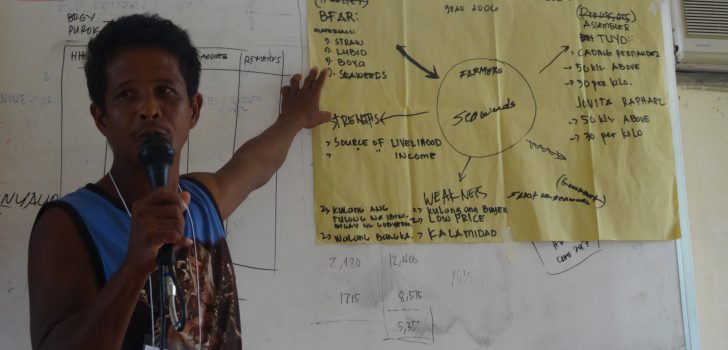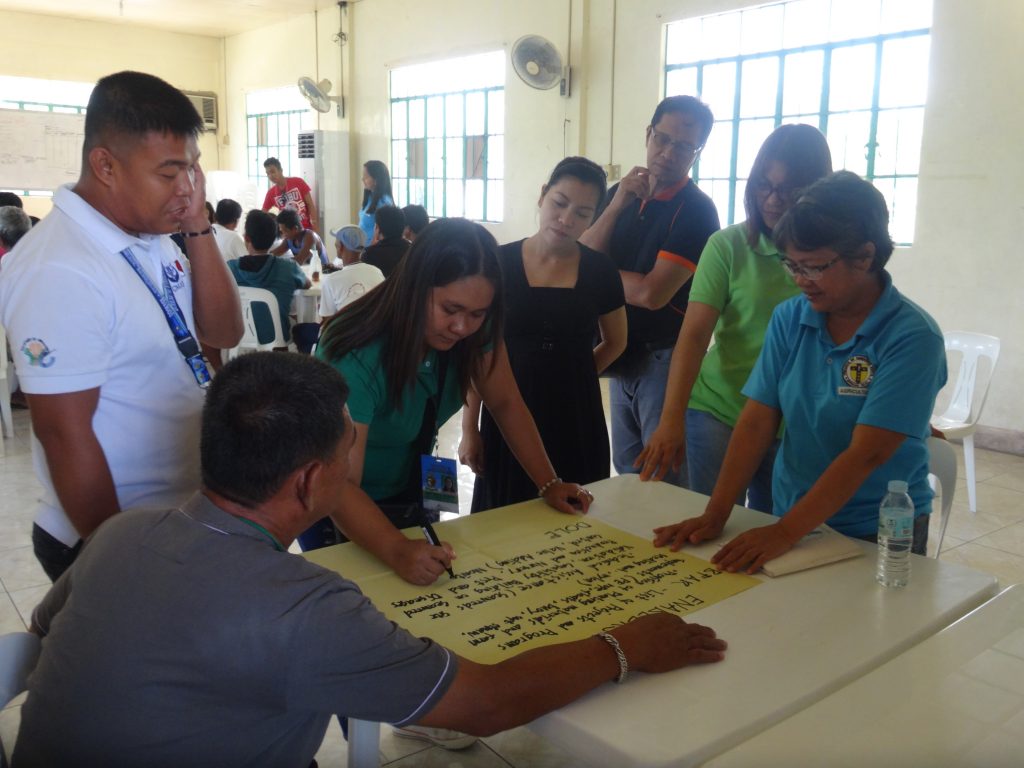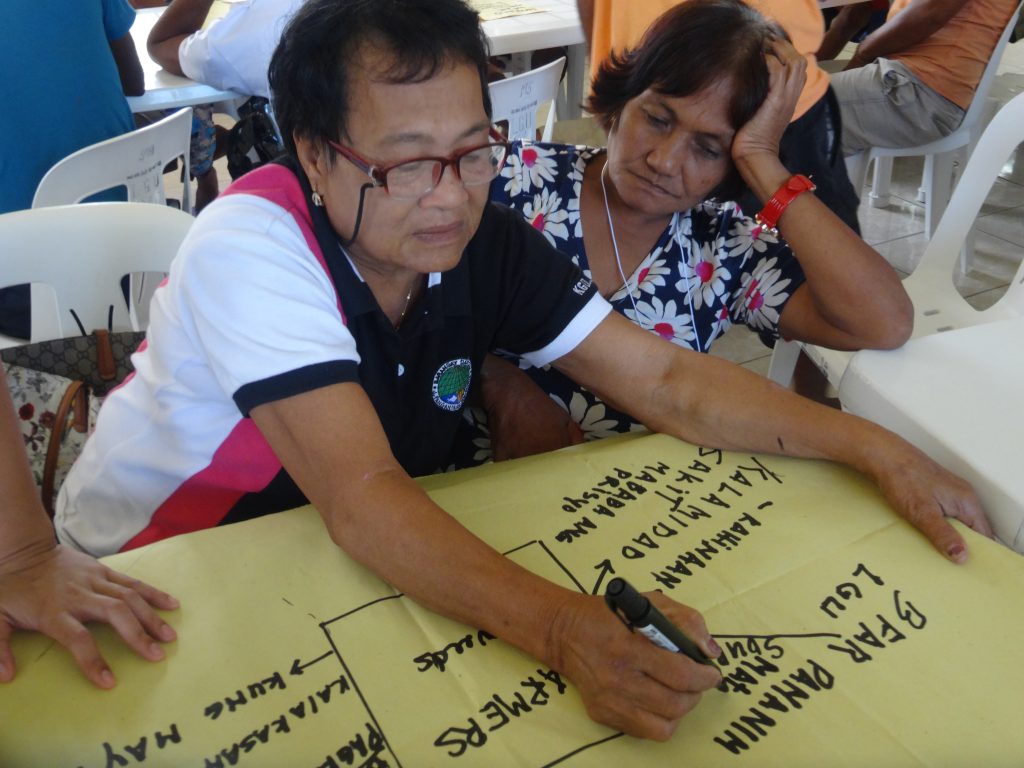 Ronaldo Brozo, seaweed grower from Brgy. Banocboc, Sitio Sugod, Vinzons, Camarines Norte, shows the strengths and weaknesses of growing seaweeds and the interventions needed to succeed in the seaweed industry. (Photo by: Michelle Angela G. Alfigura, DA-PRDP RPCO 5 InfoACE Unit)
Ronaldo Brozo, seaweed grower from Brgy. Banocboc, Sitio Sugod, Vinzons, Camarines Norte, shows the strengths and weaknesses of growing seaweeds and the interventions needed to succeed in the seaweed industry. (Photo by: Michelle Angela G. Alfigura, DA-PRDP RPCO 5 InfoACE Unit) Camarines Norte farmers plan to upgrade seaweed industry with DA-PRDP
“Sa seaweeds maganda na ang kita, konti pa ang gastos (In seaweeds production, we gain income with less cost),” said Ronaldo Brozo, seaweed farmer from Brgy. Banocboc, Sitio Sugod, Vinzons, Camarines Norte.
Camarines Norte is one of the top producers of seaweeds in the Bicol Region. Seaweed farming started to become popular in the province in 1995.
Brozo has cultivated seaweeds for almost 15 years now together with his wife and two children. Like him, many residents near the coastal area ventured in seaweed farming, because of the earnings they gain with minimal expenses and effort. The seaweed farmers sell fresh seaweeds as planting propagules for P12 to P15 per kilo and raw dried seaweeds for P22 to P30 per kilo.
According to the Fisheries Situationer of the Philippine Statistics Authority, seaweed farming in the region contributed about 34,199 metric tons to the total 1.40 million metric tons of seaweed production in the Philippines in 2016.
Due to the prevalent infestation of ice-ice disease and epiphytes in many farms in Camarines Norte, however, seaweed growers stopped their operations. Also with the high cost of production inputs and low buying price of traders, some of the farmers even opted to stop planting altogether and engaged in other jobs like fish caging and fishing to provide the needs of their family.
To identify the appropriate interventions that the PRDP can offer, the PRDP Bicol local and national level planning (I-PLAN) component conducted a series of Seaweeds Stakeholders Consultation in preparation for the writing and finalization of the Regional Seaweeds Value Chain Analysis. The said activity was attended by key players in seaweeds value chain at the Vinzons Training Center in Camarines Norte.
During the said activity, the seaweed farmers, traders, and representatives of government agencies shared their insights about the current situation of the seaweed industry in the province particularly the constraints and development gaps that need to be addressed.
The formulation of a value chain analysis for raw and dried seaweeds is deemed to be essential in establishing an industry overview and identifying key strategies that will help improve the seaweed industry of Camarines Norte.
Helbert Mabeza of the Bureau of Fisheries and Aquatic Resources (BFAR) said that the agency provides planting materials and farm implements such as polyethylene or PE ropes, buoy, soft straw, seeding mat, and nylon. The BFAR also provides technical assistance on seaweeds site validation, capability building on seaweed production and nursery, pest and diseases control, and value adding activities. Moreover, it distributed one ton of seaweeds for 10 families in the different barangays in Camarines Norte.
On the other hand, Department of Labor and Employment (DOLE) representative, Renalyn Alano, shared that DOLE provides common service facilities such as machines and equipment for seaweed processing and administers assistance to peoples’ organizations (POs) registration.
In addition, the representatives of the provincial and municipal local government units (LGUs) mentioned about their provision of technical assistance, monitoring and evaluation, area and site validation, policy regulation, strengthening of POs, establishment of seaweed nursery, and linkaging/networking with other concerned agencies.

The representatives of the municipal and provincial local government units (M/PLGUs) share their insights based on the needs and possible interventions that they can offer to the seaweed growers of Camarines Norte. (Photo by: Michelle Angela G. Alfigura, DA-PRDP RPCO 5 InfoACE Unit)
The participants actively shared their insights and experiences as well with the representatives of the LGUs and other government agencies. They discussed their dream of hiring seaweed growers and having bigger motorized boats, mechanical driers, and their own food processing facility.
Many of the said seaweed growers still focus on increasing the number of their seaweed harvests, not on processing it. The farmers said that they want to learn how to process seaweeds, because it will surely help increase their income.
“Masaya kami sa tulong na natatanggap namin. Malaki ang maitutulong nito sa kumunidad namin, dahil maari itong makapagbigay ng hanap-buhay sa amin (We are very grateful for the help that we are receiving. This will be a great help to our community, because it may provide us with a source of income),” Brozo expressed. ### (Michelle Angela G. Alfigura, DA-PRDP RPCO 5 InfoACE Unit)

